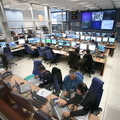Jules Verne successfully delivered 811 kg of refuelling propellant |
ESA’s Jules Verne ATV was used for the first time yesterday to transfer in one step 811 kg of refuelling propellant to the International Space Station while the two vehicles orbited Earth at 28 000 km/h. With this premiere for Europe, Jules Verne becomes the first western spaceship to succeed in refuelling another space infrastructure in orbit.
It took less than half an hour to automatically transfer about 280 kg of the Russian UDMH (Unsymmetrical dimethylhydrazine) propellant fuel and 530 kg of Nitrogen Tetroxide (N2O4), (which provides a source of oxygen so the fuel can ignite and burn in orbit) to the International Space Station's (ISS) own Russian-built propulsion tanks.
Because of the toxic and explosive characteristics of the hydrazine, the transfer is done through dedicated pipes located outside the pressurized structures of the Automated Transfer Vehicle (ATV) and the Station. The fuel lines run from the ATV, through the docking mechanism to the Space Station's own plumbing.
ATV was prepared for refuelling by the ATV Control Centre |
The ISS crew was not involved in the refuelling operation – at the time they were busy preparing for a spacewalk scheduled for early July. ATV was prepared for refuelling operations by ATV Control Centre in Toulouse. After the necessary verifications to ensure no leakage was present in the complete ATV piping system, Moscow Control Centre initiated the automatic refuelling procedure sequence, with the active support of the small Engineering Support Team co-located in the Moscow Control Centre.
“We are impressed by this new achievement of Jules Verne ATV, which went without a hitch. And we really have to congratulate the teams of RSC Energia, Astrium and Thales Alenia Space for their years of efforts to integrate the Russian refuelling system in the ATV from the hardware and software point of view” said Massimo Cislaghi, ESA's leader of the Engineering Support Team.
During the refuelling operation, some 20 people were working on the ISS in the Moscow Control Centre, with 5 Russian ATV experts and 3 ESA ATV specialists who all are part of the Engineering Support Team located in Moscow. Meanwhile, 30 people were monitoring all ATV's critical functions at the ATV Control Centre in Toulouse where cheers and applause marked the end of the fuel transfer.
Tanks inside Jules Verne were loaded with Russian fuel ahead of the launch |
The refuelling capabilities of ATV and the Russian Progress capsules are identical with a maximum fuel load of 850 kg. Even if ATV has about three times the payload capability of the Progress, they use exactly the same tanks and the same interface through the ATV docking mechanism with the Station. The Russian ISS service module is the only Station element to have a propulsion system which allows to reboost the whole Station in order to overcome the effects of residual atmospheric drag.
“We have now successfully performed all the nominal operations of Jules Verne, such as the ISS attitude control, the ISS reboost, the gas transfer of air, the water transfer, the dry cargo and now the refuelling. Only undocking and re-entry remain, which we hope to do in September,” said Hervé Côme, ESA's ATV Mission Director at the ATV Control Centre in Toulouse, France.
Jules Verne ATV has successfully performed all nominal operations |
One day after the transfer, on 18 June, the ATV teams in Moscow purged all the fuel lines which were used for the transfer between ATV and the Station. This eliminates the risk of toxic contamination from about 13 kg of fuel which could leak when Jules Verne ATV undocks from the International Space Station in September. Jules Verne ATV was launched from Kourou in French Guiana on 9 March 2008 and docked to the ISS on 3 April 2008. “Today, Europe has gained a new space capability which represents a new step towards human spaceflights and advanced exploration programmes”, said Jean-François Clervoy, ATV senior advisor and a member of ESA's Astronaut Corps. “ATV is the only western vehicle able to refuel another spacecraft in complement to the Russian Progress. The successful automation of this function frees significant crew time for other ISS operations.”
Original here











 Billed as the world's largest science project, the LHC was unveiled to unearth the so-called "God particle". Early blogs and articles surmised that the device wielded so much energy that it might create a black hole (though scientifically inaccurate, it hinted at the awesome energy waiting to be unleashed.)
Billed as the world's largest science project, the LHC was unveiled to unearth the so-called "God particle". Early blogs and articles surmised that the device wielded so much energy that it might create a black hole (though scientifically inaccurate, it hinted at the awesome energy waiting to be unleashed.) This first-ever demo-level fusion reactor will be built in southern France and promises to deliver the world's first sustained fusion reactions; In layman's terms: more bang for your buck. And at a projected cost of CDN $14.4 billion, it better.
This first-ever demo-level fusion reactor will be built in southern France and promises to deliver the world's first sustained fusion reactions; In layman's terms: more bang for your buck. And at a projected cost of CDN $14.4 billion, it better. When completed in 2010 (though that will likely slip to 2011) the International Space Station will be the largest multinational engineering project of all time.
When completed in 2010 (though that will likely slip to 2011) the International Space Station will be the largest multinational engineering project of all time. Dubbed the "Solar Mission Project", this scientific feat takes solar energy to new heights.
Dubbed the "Solar Mission Project", this scientific feat takes solar energy to new heights. Many studies and tests have been done to give the Earth a regular health checkup, including a comprehensive study of climate-change studies. The difference here is that, rather than sending out a research vessel to the High Arctic, or analizing data from remote sensing instruments amongst one or two teams, this project is using the idle computer time of thousands of volunteers to crunch climate-change data. Though the results are scary, the analysis is impressive in its scope, running on a set-up similar to the popular SETI@home screensaver program. (
Many studies and tests have been done to give the Earth a regular health checkup, including a comprehensive study of climate-change studies. The difference here is that, rather than sending out a research vessel to the High Arctic, or analizing data from remote sensing instruments amongst one or two teams, this project is using the idle computer time of thousands of volunteers to crunch climate-change data. Though the results are scary, the analysis is impressive in its scope, running on a set-up similar to the popular SETI@home screensaver program. ( What's after Hubble? Around when NASA is ready to retire one of the most successful science instruments of all time, the James Webb Space Telescope will launch into an ultra-high orbit 1.5 million km from Earth (compare that to the 500 km Hubble orbits above our world.) Out there in the cool vacuum, protected from the sun by a tenis-court-sized shield, the JWST will to try and find the first galaxies that formed in the early Universe. JWST will also be able to peer through dusty clouds to see stars forming planetary systems, connecting the Milky Way to our own Solar System.
What's after Hubble? Around when NASA is ready to retire one of the most successful science instruments of all time, the James Webb Space Telescope will launch into an ultra-high orbit 1.5 million km from Earth (compare that to the 500 km Hubble orbits above our world.) Out there in the cool vacuum, protected from the sun by a tenis-court-sized shield, the JWST will to try and find the first galaxies that formed in the early Universe. JWST will also be able to peer through dusty clouds to see stars forming planetary systems, connecting the Milky Way to our own Solar System. Known to some as the "Doomsday Vault" or "Noah's Ark for Seeds", this seed bank just might deliver us (and the seeds) from extinction should disaster strike in some not-too-distant future.
Known to some as the "Doomsday Vault" or "Noah's Ark for Seeds", this seed bank just might deliver us (and the seeds) from extinction should disaster strike in some not-too-distant future. Simply put, this project aims to take space-bound human travels to new heights - into orbit to be precise.
Simply put, this project aims to take space-bound human travels to new heights - into orbit to be precise. In short, ANTARES (Astronomy with a Neutrino Telescope and Abyss environmental RESearch project) and its counterpart to South Pole neutrino telescopes AMANDA and IceCube Neutrino Detector is a telescope designed to look down while its more-traditional star-gazing cousins look up. Don't think there's much to see? Think again.
In short, ANTARES (Astronomy with a Neutrino Telescope and Abyss environmental RESearch project) and its counterpart to South Pole neutrino telescopes AMANDA and IceCube Neutrino Detector is a telescope designed to look down while its more-traditional star-gazing cousins look up. Don't think there's much to see? Think again. Honorable mention: Canadian connection - Canadian Light Source Synchrotron
Honorable mention: Canadian connection - Canadian Light Source Synchrotron Honorable mention: Trans-Atlantic Mag-lev
Honorable mention: Trans-Atlantic Mag-lev









